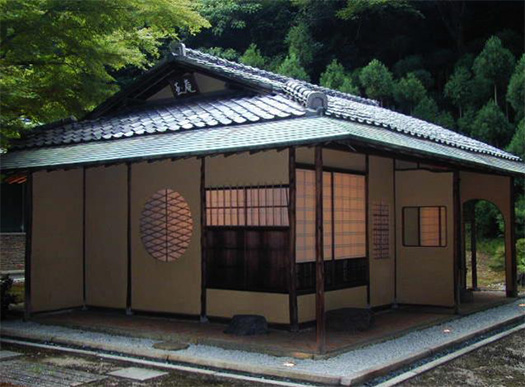

先日まで日本の古民家空間に残る床の間の原型「押板」から
日本的芸術コミュニケーションの場としての意味合いを考えた。
中世社会がこのような「寄り合い」の場のなかで
人間交流の結果として、その媒介に「茶」を選択し、
またその波及として「華道」空間としての床の間を生成したのではと
推論を発展させてきた。
禅宗と深く関わるカタチで茶道が広く普及していって
たぶんビジネス的ホンネ密談という実質価値もあって
茶室という稀有な空間性を日本社会は生み出してきた。
そしてさらに日本の民家空間におかしな空間名称として
「お茶の間」というコトバが生起してきている。
わたしも住宅雑誌人として数多くの「間取り図」を見ているけれど
明確に「茶の間」と書かれた空間名称はあまり記憶にない。
ふつうは居間とかリビング、古民家では「デイ」とか「ジョイ」と呼ばれる空間で
囲炉裏がそこに切られている居室はたくさん見るけれど。
現代住宅ではエネルギー革命が進行して調理火力には
ガスが普及し電気も使われるようになった。
従って人類創成期からの調理火力・薪は役割が減衰してきている。
いずれにせよ、食事と家族団欒の場には「茶」が主役ではなかったはずだ。
それなのにテレビの司会の常套句で「お茶の間のみなさん」とか、
あたかも普遍的ニッポン人すべてがそこにいるように連呼する。
茶の間が茶室を意味するのであれば、わが家には茶の間はない。
たぶん多数派の日本人の家にもないだろう。
というよりも形式とか、家元制度で重厚に自己武装している
「茶道」の決め事強制には辟易する方が多い。
茶筅をどうする、どう扱うとか、どう茶を飲むかとか、
「うっせーわ」と思う日本人は多いに違いない。
そんな「作法」に従わなくてもふつうに茶を飲むことはできる。
ああした作法の強制は、家元制度に重々しさを加えることが目的だと
多くの人間がただしく気付いているのではと思う。
たぶん草創期からの茶、その喫茶においては寄り合う楽しさ、
そこでさまざまに話題が盛り上がる様子に多くの人が吸い寄せられたに違いない。
その句読点として喫茶は非常に重要な役割ではあったのではないか。
いつしか茶を喫することがコミュニケーションの活性を表現するようになった。
そしてその最たるものとして家族関係が表徴されることになって
「茶の間」=家族コミュニケーションの最適空間と置換されたか。
だから、囲炉裏のある空間がイメージのなかで
茶の間とされて、事実家族も食事後、茶を飲むことが普遍的だったのではないか。
「お茶の間のみなさん」とは、「家でくつろいでいるみなさん」という
言い換えのコトバが習慣化したものであるように思う。
住宅雑誌編集人としての実感なのですが、さていかがでしょうか?
English version⬇
[Architectural space called the living room that does not appear on the floor plan]
From the prototype “Oshiban” between the alcove that remains in the old Japanese folk house space until the other day
I thought about the meaning as a place for Japanese art communication.
In such a place where medieval society is “close”
As a result of human interaction, select “tea” as the medium,
Also, as a ripple effect, it may have created a tokonoma as a “flower arrangement” space.
Has developed reasoning.
Tea ceremony has become widespread because of its deep connection with Zen Buddhism.
Maybe there is also the real value of a business-oriented secret talk
Japanese society has created a rare space called a tea room.
And as a strange space name in Japanese private house space
A word called “living room” is emerging.
As a housing magazine person, I also see many “floor plans”
I don’t remember much of the space name clearly written as “living room”.
Usually in the living room or living room, or in a space called “day” or “joy” in an old folk house.
I see many rooms with a hearth cut there.
In modern houses, the energy revolution is progressing and cooking firepower
Gas has become widespread and electricity has come to be used.
Therefore, the role of cooking firepower and firewood from the early days of humankind is declining.
In any case, “tea” should not have been the main character in the place of meals and family gatherings.
Even so, the TV moderator’s idiom is “everyone in the living room.”
Call as if all the universal Japanese were there.
If the living room means a tea room, there is no living room in our house.
Probably not even in the majority Japanese homes.
Rather, it is heavily self-armed by the form or the Iemoto system.
There are many people who are tired of forcing the decision of “tea ceremony”.
What to do with chasen, how to handle it, how to drink tea,
There must be many Japanese who think “Usseewa”.
You can usually drink tea without following such a “method”.
The purpose of the enforcement of such a manner is to add weight to the Iemoto system.
I think many people are aware of it.
Maybe tea from the early days, the fun of getting close to each other at the coffee shop,
Many people must have been attracted to the various topics that have been raised there.
I think the coffee shop played a very important role as a punctuation mark.
Someday, having tea has come to express the activity of communication.
And the most important thing is that family relationships will be expressed.
Was it replaced with the “living room” = the optimal space for family communication?
Therefore, the space with the hearth is in the image.
It was said that it was a living room, and in fact it was universal for families to drink tea after meals.
“Everyone in the living room” means “everyone relaxing at home”
In other words, I think that Kotoba has become a habit.
I have a feeling as an editor of a housing magazine, but how about it?
Posted on 4月 26th, 2021 by 三木 奎吾
Filed under: 住宅マーケティング, 日本社会・文化研究







コメントを投稿
「※誹謗中傷や、悪意のある書き込み、営利目的などのコメントを防ぐために、投稿された全てのコメントは一時的に保留されますのでご了承ください。」
You must be logged in to post a comment.